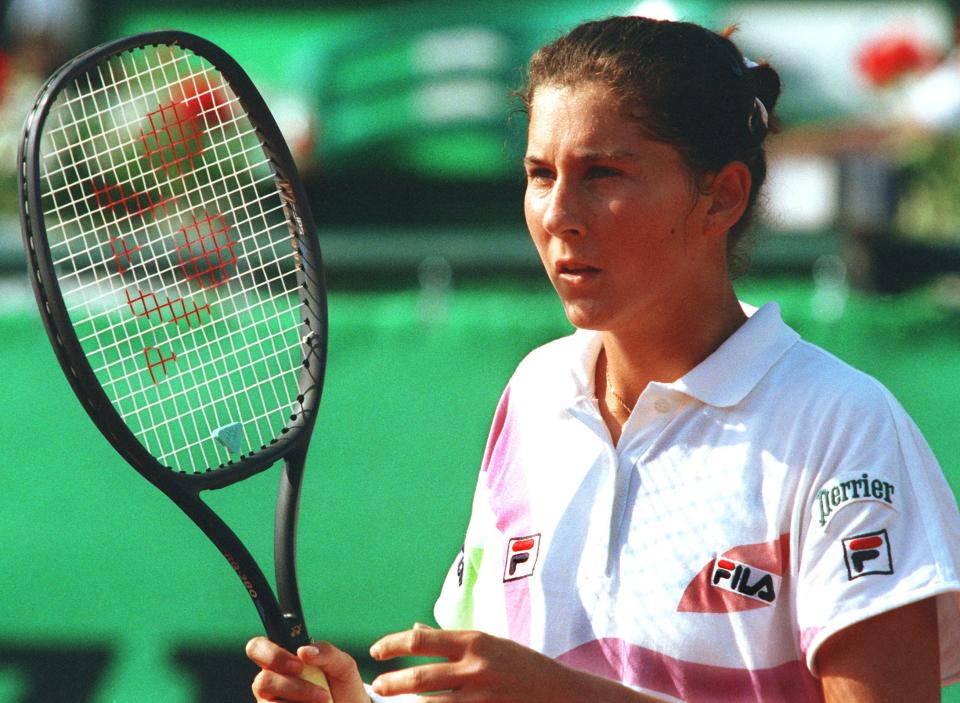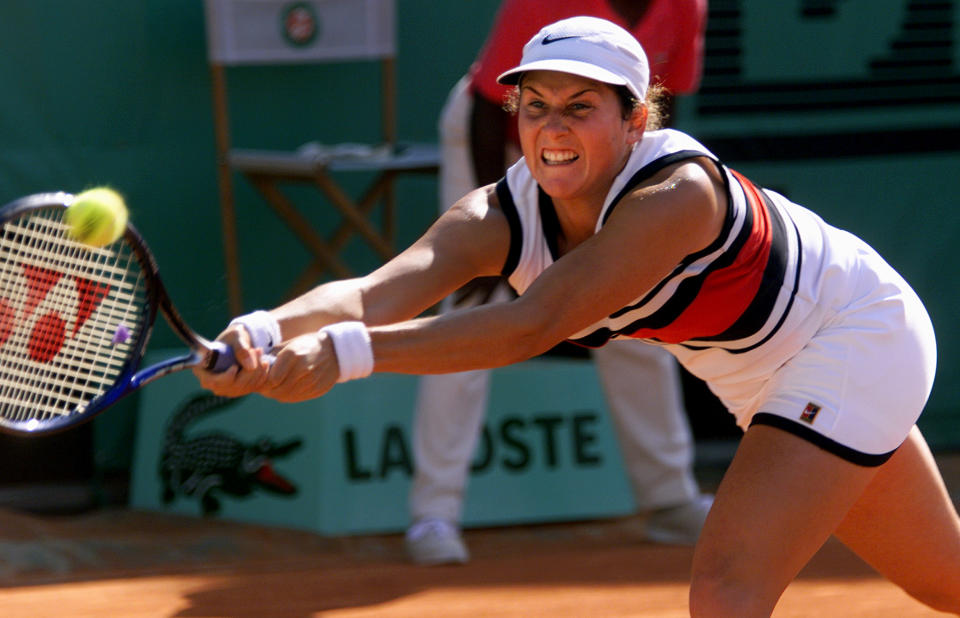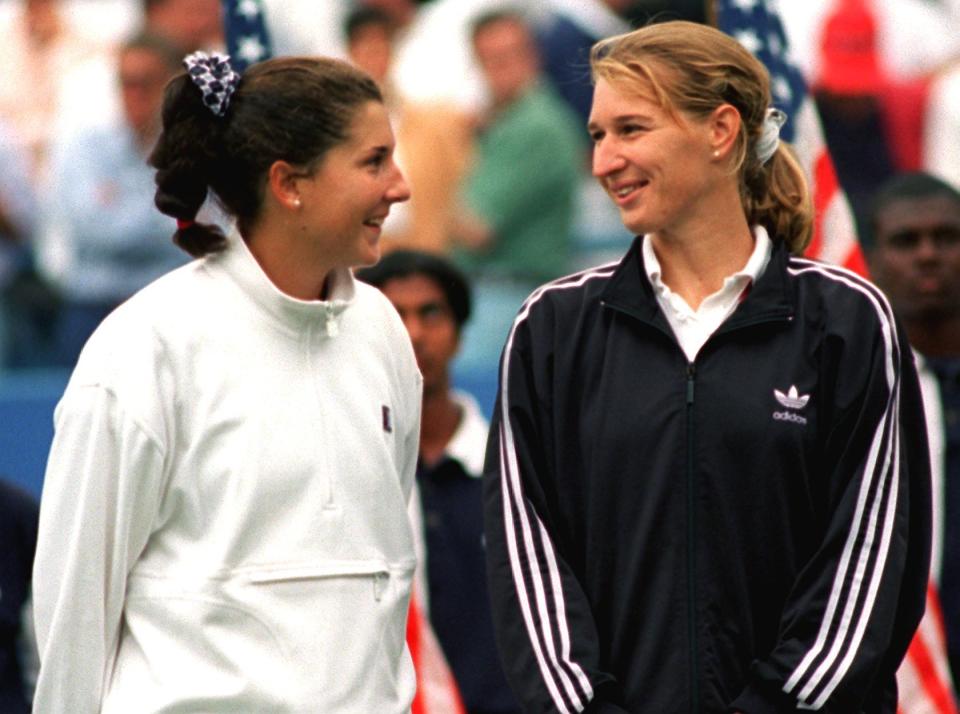This day in sports history: On-court attack of Monica Seles robs tennis of all-time great run

Yahoo Sports is digging into the archives, taking a look back at the moments that shaped sports.
In 1993, Monica Seles was untouchable.
The 19-year-old was in the midst of an extraordinary tennis run, having taken over the women’s circuit from Steffi Graf, poised to rewrite the game’s history book as perhaps its greatest-ever champion.
Then on April 30, everything changed. A depraved fan robbed Seles of her security and well-being while denying the sport a potential historic run of greatness and an iconic rivalry.
Seles’ dominance
Seles was commanding on clay. She had won three consecutive French Open titles, including her first major title in 1990 at Roland Garros at 16 years old. In fact, she was dominant almost everywhere.
Seles had claimed seven of the nine previous Grand Slam titles, with three straight wins at the Australian Open and two at the U.S. Open in addition to her French Open victories. Only success at Wimbledon’s grass courts eluded her grasp.

She had defeated Graf in three out of four major finals matchups and taken over the No. 1 ranking from the then 11-time Grand Slam champion. This was Seles’ time.
The attack
That day, Seles took on Magdalena Maleeva in the quarterfinals of the Citizen Cup in Hamburg, Germany, a warmup event for the French Open.
She led Maleeva 6-4, 4-3 when the players took a water break. Then the unthinkable happened, a moment that shocked the tennis world and beyond and seared its image into the minds of fans watching on that grievous day.
At first, it wasn’t clear what had happened — at least to those not in the stands directly near the incident.
A scream and then crowd murmurs were recorded on the broadcast before cameras cut to a man in the stands being restrained by spectators. The camera then panned to Seles standing and clutching her upper back with her right hand before falling to the ground where she was attended by others.
Maleeva held a towel over her face as she looked on with fear and anxiety. Seles was then helped to her feet and taken off the court on a stretcher.
She had been stabbed.
‘I didn’t understand what was happening’
Her attacker intended to stab her a second time. Seles recounted the attack in her 2009 book "Getting a Grip.”
“I remember sitting there, toweling off, and then I leaned forward to take a sip of water, our time was almost up and my mouth was dry,” Seles wrote. “The cup had barely touched my lips when I felt a horrible pain in my back.
“My head whipped around towards where it hurt and I saw a man wearing a baseball cap, a sneer across his face. His arms were raised above his head and his hands were clutching a long knife. He started to lunge at me again. I didn't understand what was happening.”
Why the attack?
The assailant was 38-year-old German Gunter Parche. Was the attack a terrorist incident? Was it politically motivated in the aftermath of Cold War Germany?
No. It was simply a case of a zealous tennis fan taking things to a violent extreme.
Parche was a Graf fan. He admitted during his confession that he simply wanted to see the German tennis player return to the No. 1 world ranking. Seles was standing in her way.
The aftermath for Seles
Seles avoided damage to her lungs and spine in the attack. The knife plunged an inch into her back, but missed vital organs and required stitches and a short hospital stay.
But physical pain lingered for months, and mental anguish exacerbated longer than that. She didn’t play tennis again for 2 1/2 years as she sought treatment for post-traumatic stress disorder. Her father Karolj was diagnosed with cancer months after the stabbing, adding to the mental toll.

“I was for so long in such a dark place,” Seles told the Los Angeles Times in 1995. “So unhappy. I thought after [the stabbing] there was no way up, I didn’t know how to go up. I felt I was in a deep hole and getting deeper. …
“If I hadn’t have done that, gone to a psychologist, it would have been bye-bye, Monica.”
Parche avoids prison time
Parche escaped a charge of attempted murder. A German court delivered a two-year suspended sentence for aggravated assault, a decision it upheld upon appeal. He never served a day in prison.
Seles eventually returned to tennis. But things were never the same. She reached the 1995 U.S. Open final, but lost to Graf in straight sets. She did defeat Anke Huber in the final of the 1996 Australian Open to claim her ninth and final Grand Slam victory.
She competed professionally until 2003, never again winning a Grand Slam after her 1996 victory at Melbourne.

Seles, tennis robbed
With her top rival robbed of her prime and her peak abilities, Graf went on to again claim the No. 1 ranking and dominate the circuit with 11 more Grand Slam victories after Seles was stabbed. Her 22 major victories now trail only Margaret Court (24) and Serena Williams (23).
Graf is one of sports’ greatest champions and rightfully deserves her spot in the annals of tennis. But would she have won 22 Grand Slams were it not for that awful day in Hamburg in 1993? Almost certainly not.
Would she be considered the greatest champion of her era? We’ll never know. Parche robbed Seles and the tennis world the opportunity to find out.

